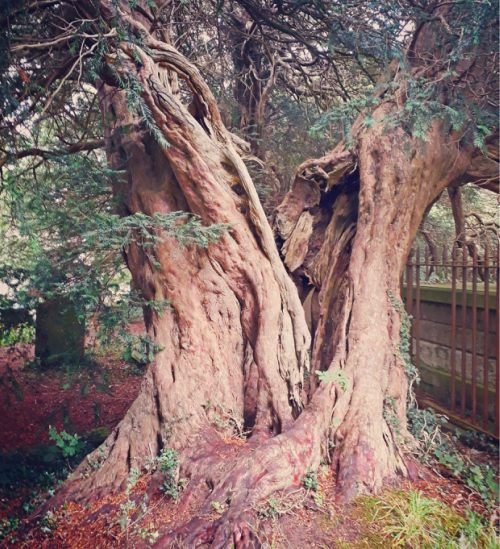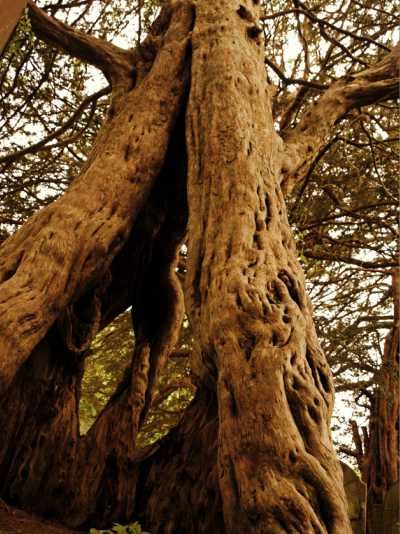I am blessed to live in a country (Wales) that boasts the highest concentration of Yew trees in the world.

Thanks to a smaller population and the lack of longbows used in warfare by our ancestors, Taxas Baccatus’ or Ywen in Welsh have stood in fields and groves here for perhaps millions of years. Yew trees are evergreen shrubs or trees that can grow up to fifteen meters high and today are usually found in graveyards. Every part of the Yew is poisonous, apart from the gooey flesh around the red arils. Today the poison of the Yew is harvested to synthesise into anti-cancer drugs. Yews are known for their hollow trunks, which can start to occur in an adult Yew once it is approximately 500 years old and it’s branches have been cut back from their natural growth, which is out and down along the ground. This pruning often happens in churchyards to keep the tree tidy and safe for visitors, but prevent the Yew to grow to it’s complete gesture and you would see a sprawling giant tangle of strong branches running along the ground and occasionally re-rooting to sprout new trees as can be seen with the famous Whittingehame Yew in Scotland. The Yew is known to be 250 million years old and has hardly changed it’s DNA during that time, in other words, it has hardly evolved at all during that time! It’s evolution is a complete mystery and how it survived natural disasters, cataclysm and ice ages is beyond our knowledge, but it has.

The Yew age certificates given to some churches and that you usually find pinned to the noticeboards in the entrance, never state an age older than 500 years, however, there is much evidence to suggest that it can live much much longer and due to it’s lack of tree rings it is impossible to accurately age. Either way, the Yew is known to be one of the longest living trees on Earth.
One of the most famous Yews in the British Isles is the Defynnog Yew in the Brecon Beacons. Thought to initially be two trees, after DNA testing it was found to be one Yew that has split in two and gradually moved or ‘walked’ apart over many years. The Yew is now separated into two halves, one with a girth of 40 feet and the other 20, yet looks like two separate trees. Thanks to the care and dedication of Yew expert, Janis Fry, this Yew tree is a contender for the oldest tree in Britain, claiming 5,000 years, rivalling the Fortingall Yew in Scotland, also estimated to be 5,000 years old by the Forestry Commission of Scotland.
There is no surprise that two of the Yew’s sobriquets are the God Tree and The Tree of Eternity and probably why the Christians decided to build their churches in the existing circles and groves of these magnificent trees (although they also chopped many of them down!). Yews were often planted on the graves of lost lovers with the intention that the two souls be joined beyond death, a famous example of this is Tristan and Isolde. And two wonderful examples of ancient Yew circles here in Wales are at Llanfeughan Church in Pencelli in the Beacons and at Cefnllys in Radnorshire, just outside Llandrindod Wells.

There is much to be said about the Yew in Christian history, even an association with Joseph of Arimathea, however, the history of the Yews here in Wales is much more ancient. In mythology and earth wisdom traditions the Yew has always been associated with mortality and infinity as well as longevity, as a gateway to the divine and to the Otherworld (Annwfn in Old Welsh). In Norse mythology, the world tree Yggdrasil was also originally thought to be the Yew and two of the five great magical trees of Ireland, where druids gathered and practiced, were Yews. This is testimony to the reverence and deep understanding of the qualities of this tree by our ancestors. The last tree in the Ogham alphabet (a mnemonic device and magical system of communication, divination and guidance at least 1700 years old), the Yew represents that which is beyond death, the ‘coming to terms with death and the endless movement of time, when it is realised that one’s actions mean nothing in the face of eternity. It is being, not doing, that we learn to be truly alive’ (Celtic Tree Magic, Danu Forest). In Celtic tradition the Yew stands between worlds, holding the still point between time space and infinity, giving us a glimpse into the world of the Gods from our mortal place on Earth.
References:
With special thanks to Paul Greenwood, Michael Dunning and Janis Fry for their dedication to the lost history of the Yew and to Danu Forest for bringing the Ogham script back to life.
Photos by me
Congratulations @emmafarrell! You have completed some achievement on Steemit and have been rewarded with new badge(s) :
Click on any badge to view your own Board of Honor on SteemitBoard.
For more information about SteemitBoard, click here
If you no longer want to receive notifications, reply to this comment with the word
STOPWow! They are absolutely breathtaking! I had no idea they were so special! They look like something out of Middle Earth. Just gorgeous. Thank you for sharing!
Thank you. We need more awareness about the magnificent trees because they are in danger of being chopped down here in the UK due to the demise of the church. Many churchyards are being sold off to developers and this is where many of our most ancient trees reside :(
By the way, I live where Tolkein lived and I believe he got the tree consciousness for the ents from yews. Yoda from Star Wars also is an old word for Yew!
Hi @emmafarrel. I really love your post. Yews are amazing and I did not even know them... Thank you for sharing!
Thank you for your kind words, I am delighted to have inspired you. xx
Enjoyed the write-up. Consider yourself upvoted and followed.
Thank you so much!
Such beautiful Tree's and very sacred, I have always loved to be around them, but not been around any the last few years. I go to Ireland this year so will be looking to visit some then.
Thanks trucklife-family! Enjoy the Emerald Isle, both my husband and I have Irish blood and visit often x
thank you, my family are all there and two of my daughters were born there x